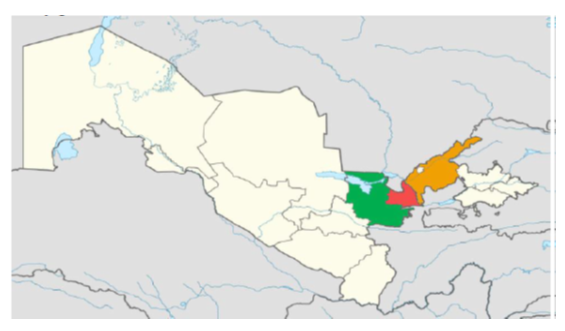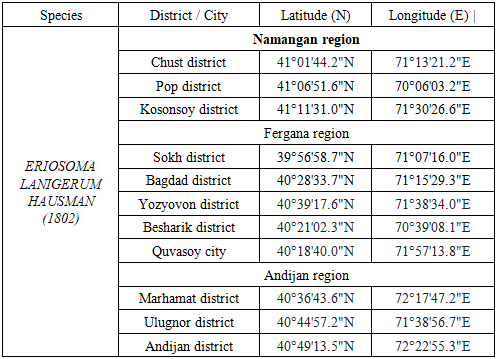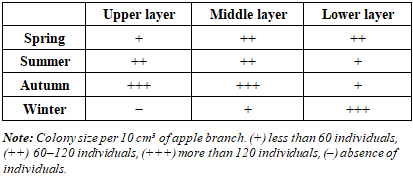Komoliddin Ganiev1, Abdujabbor Mirzaliyev2
1Candidate of Biological Sciences, Associate Professor, Department of Medical Biology and Chemistry, Central Asian Medical University, Fergana, Uzbekistan
2Lecturer, Department of Zoology and General Biology, Fergana State University, Fergana, Uzbekistan
Correspondence to: Komoliddin Ganiev, Candidate of Biological Sciences, Associate Professor, Department of Medical Biology and Chemistry, Central Asian Medical University, Fergana, Uzbekistan.
| Email: |  |
Copyright © 2025 The Author(s). Published by Scientific & Academic Publishing.
This work is licensed under the Creative Commons Attribution International License (CC BY).
http://creativecommons.org/licenses/by/4.0/

Abstract
This article provides information on the specific ecological features of the woolly apple aphid Eriosoma lanigerum (Hausmann, 1802) in different altitudinal zones of the Fergana Valley. The research was carried out in mountainous, foothill, and desert regions of the valley. The seasonal occurrence of E. lanigerum in various layers of apple trees and the population density of individuals were analyzed, compared, and discussed with precise data.
Keywords:
Eriosoma lanigerum, Population density, Aphis pomi De Geer, aphid, Malus domestica L., Tree layers, Phenological method, Relief
Cite this paper: Komoliddin Ganiev, Abdujabbor Mirzaliyev, Specific Features of the Distribution of Eriosoma Lanigerum in Different Altitudinal Zones of the Fergana Valley, International Journal of Genetic Engineering, Vol. 13 No. 9, 2025, pp. 187-189. doi: 10.5923/j.ijge.20251309.04.
1. Introduction
The orchards established in the Fergana Valley consist mainly of pome and stone fruit trees. The mountainous and foothill regions of the valley are largely specialized in fruit growing, and apple (Malus domestica L.) orchards occupy a significant share. In addition to favorable soil composition, climatic conditions, and abundant water resources, which make horticulture possible, these factors also create suitable habitats for pest insects. Considering this, the distribution of Eriosoma lanigerum - one of the most harmful apple pests and the seasonal arrangement of its populations in ecological niches is of great importance for study.
2. Literature Review and Methods
The Fergana Valley is a major tectonic depression in Central Asia, located in the eastern part of Uzbekistan (partly within Tajikistan and Kyrgyzstan). The valley is surrounded in the north and northeast by the southern branches of the Tien Shan mountain system (Chatkal, Qurama, and Fergana ranges), and in the south by the spurs of the Gissar-Alay system (Turkistan and Alay ranges). Its surface can be divided into several altitudinal zones.The first zone consists of the central part of the depression and areas up to the present bed of the Syrdarya River at an elevation of 300–400 m [2]. Here, the slopes extend about 200 km eastward, southeastward, and southwestward, with a vertical range of about 80 m. This zone includes saline soils, depressions, and sandy dunes. | Figure 1. The study areas of the Fergana Valley where the present research was conducted |
The third zone includes the foothills at an altitude of 600–1200 m. Beyond these foothills lie alluvial plains, from which the mountains surrounding the valley begin [9].The feeding characteristics of aphids and the organization of their ecological niches were first studied by M. Ahmedov, who identified the main indicators defining ecological niches. He analyzed the degree of damage caused by aphids across vertical zones and explained the reasons for changes in ecological niches, providing the first classification of their feeding sites [1].According to scientific sources, Eriosoma lanigerum (Hausmann, 1802) was first described from apple trees in the eastern part of North America as a member of the genus Aphis, and in this region, its populations undergo a complete life cycle. The species was introduced into the territory of Russia in 1862 and into Uzbekistan in 1905 together with apple seedlings. It has also been reported as distributed across nearly all countries of Central Asia [2,3,10].In our research, the occurrence of E. lanigerum on host plants across various regions of the Fergana Valley was analyzed in detail.The distribution of E. lanigerum in different ecological zones was studied by recording its presence in the upper, middle, and lower layers of apple trees and counting the individuals within colonies. The phenological development of apple plants was studied using the Beydemen method, which included regular monitoring every 10 days during the growing season. The age, size, and canopy structure of the observed trees were taken into account [4]. In addition, material collection and observations followed the methodologies of M. Ahmedov, A.K. Mordvilko, G.X. Shaposhnikov, V.A. Mamontova-Solukha, and I.A. Cherkasova [5,6,7]. During the study, more than 10 local apple trees were monitored. On each tree, 100 cm segments were selected in each layer, and aphid colonies were examined in those specific parts. The ecological features and taxonomic characteristics of the aphids were analyzed using specialized aphidological literature. The dynamics of population development (periods of increase and decline) were determined [8]. The geographic coordinates of the research sites were obtained using Google Maps software [9]. Table 1. Geoinformation on the distribution of Eriosoma lanigerum aphid across regions of the Fergana Valley
 |
| |
|
3. Results and Discussion
Our research analyzed the distribution patterns of the woolly apple aphid (Eriosoma lanigerum) across the mountainous, foothill, and plain regions of the Fergana Valley, taking into account temperature conditions and the influence of other pests on its occurrence within different layers of apple trees.Table 2. Distribution of Eriosoma lanigerum in the plant canopy layers of the mountainous region
 |
| |
|
In the mountainous areas Pop district (41°06'51.6"N, 70°06'03.2"E), Sokh district (39°56'58.7"N, 71°07'16.0"E), Kosonsoy district (41°11'31.0"N, 71°30'26.6"E), Chust district (41°01'44.2"N, 71°13'21.2"E), observations revealed that colonies of E. lanigerum begin developing by late April–early May (28.04.22–06.05.2022). At this stage, colonies were less frequent in the upper canopy due to dominance by the green apple aphid (Aphis pomi De Geer, 1773). The woolly apple aphid was more abundant in damaged areas of the middle canopy and on 2–3-year-old branches, while its density in the lower canopy was similar to that of the middle canopy.During summer populations of E. lanigerum were moderate in the upper and middle layers because A.pomi decreased under high temperatures, allowing E. lanigerum to expand. However, the number of individuals in the lower canopy declined, likely due to upward migration toward more favorable microclimatic conditions (10–14.06.2022).In early autumn aphid colonies reached peak abundance in the upper and middle layers. By November, colonies began shifting downward to the lower canopy (28.09–04.10.2022).In winter no individuals were found in the upper canopy, while small colonies persisted in the middle branches under bark cracks. Dense colonies were mostly concentrated in the lower canopy (11–13.12.2022).Similar studies were also conducted in the foothill zone.Table 3. Distribution of Eriosoma lanigerum in the plant canopy layers of the foothill region
 |
| |
|
In the foothill areas — Marhamat district (40°36'43.6"N, 72°17'47.2"E), Quvasoy city (40°18'40.0"N, 71°57'13.8"E), and Besharik district (40°21'02.3"N, 70°39'08.1"E) — the earlier onset of warmer temperatures compared to the mountainous region contributed to the formation of moderate populations of the woolly apple aphid in the upper and lower canopy layers. In contrast, high colony densities were recorded in the middle canopy layers (6.04–10.04.2022).Observations during the summer indicated that rising air temperatures negatively affected the survival of E. lanigerum, resulting in a reduced number of individuals in the upper canopy. However, colonies were abundant in the middle and lower canopy layers (10.06.2022). By the end of summer, this pattern slightly changed, as colonies began to increase again in the upper canopy.In the desert zone, temperature conditions differ significantly compared to other regions, and variations were also observed in the occurrence of other pests. In the areas where we conducted research — Yozyovon district (40°39'17.6"N, 71°38'34.0"E), Bagdad district (40°28'33.7"N, 71°15'29.3"E), and Ulugnor district (40°44'57.2"N, 71°38'56.7"E) — the host plants showed the following results.Table 4. Distribution of Eriosoma lanigerum in the plant canopy layers of the desert region
 |
| |
|
In the spring, the population density of aphids in the upper and middle canopy layers of apple trees in the desert zone was observed to be at a moderate level. This can be explained by the early rise in temperature and the creation of favorable conditions for aphid development in desert areas (28.04–05.05.2022).During the summer, the high increase in temperature led to the complete absence of colonies of this species in the upper canopy, while moderate populations were recorded in the middle and lower layers (20.06–24.06.2022).In autumn, optimal temperature conditions for aphids were observed, which allowed the pest to be present even in the upper canopy. In the middle and lower layers, population densities remained at moderate levels (28.09–02.10.2022).In winter, representatives of the woolly apple aphid completely disappeared from the upper and middle canopy layers, while only small numbers persisted in the lowest layer (10.12–14.12.2022).
4. Conclusions
The structure of the Fergana Valley is divided into several altitudinal zones, which directly influence the formation of its flora and fauna. In particular, our research confirmed that small insects such as aphids are not uniformly distributed across these zones. Following the introduction of the species Eriosoma lanigerum into the valley, we observed its initial establishment in foothill areas, followed by its spread to mountainous and desert regions. The results demonstrated that this species does not occur with the same population density across mountain, foothill, and desert zones, and clear seasonal differences were also identified. These findings provide evidence of ecological and biological distinctions in the species across different habitats. Based on our study of this species, partial conclusions can also be drawn regarding the zoogeographic distribution of other related species, and future research in this direction is recommended. This article may thus be considered among the first contributions describing the distribution of Eriosoma lanigerum in ecological niches of the Fergana Valley.
References
| [1] | Akhmedov, M.Kh. (1994) Aphids (Homoptera, Aphidinea, Aphididae) of the arid-mountainous zones of Central Asia: ecology, faunogenesis, taxonomy. Dissertation. Fergana, pp. 6–7. |
| [2] | Baratov, P., Mamatqolov, M. & Rafiqov, A. (2002) Physical Geography of Central Asia. Tashkent: Oʻqituvchi, 439 pp. |
| [3] | Yakhontov, V.V. (1962) Agricultural Pests of Central Asia. Tashkent: “Urta va Oliy Maktab” State Publishing House, pp. 499–500. |
| [4] | Jaume, L. & Simó, A. (2015) Woolly apple aphid Eriosoma lanigerum Hausmann: ecology and its relationship with climatic variables and natural enemies in Mediterranean areas. Bulletin of Entomological Research, 105, 60–69. https:/doi.org/xxxx (https://doi.org) |
| [5] | Beideman, I.N. (1974) Methods for Studying the Phenology of Plants and Plant Communities. Novosibirsk: Nauka, 154 pp. |
| [6] | Mordvilko, A.K. (1910) Instructions for observing aphids (Fam. Aphididae), collecting and preserving them. Instructions for Collecting Zoological Collections, 7, Siberia, pp. 21–56. |
| [7] | Shaposhnikov, G.Kh. (1952) Instructions for collecting aphids. Vol. 21. Moscow–Leningrad: USSR Academy of Sciences Publishing House, 21 pp. |
| [8] | Gabrid, N.V. (1989) Aphids of Trees and Shrubs of the Issyk-Kul Region. Frunze: Ilim, 186 pp. |
| [9] | Google. (n.d.). Google Maps: Interactive online map [Online map]. https://www.google.com/maps. |
| [10] | Hausmann, F. (1802). Beiträge zu den Materialien für eine künftige Bearbeitung der Gattung der Blattläuse. Magazin für Insektenkunde, 1(3–4), 426–445. |




 Abstract
Abstract Reference
Reference Full-Text PDF
Full-Text PDF Full-text HTML
Full-text HTML


